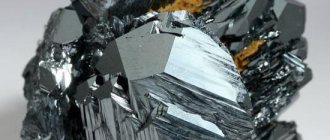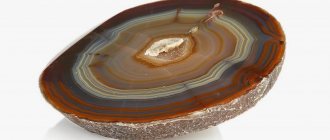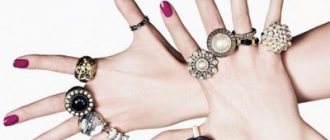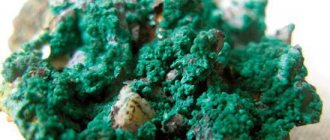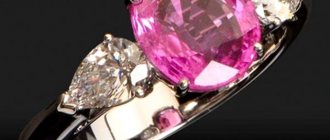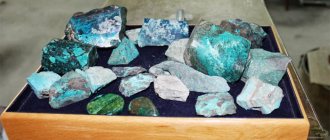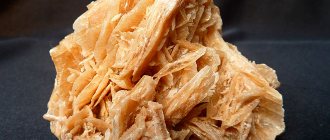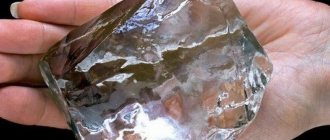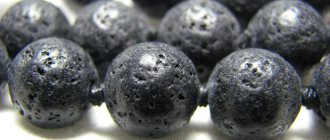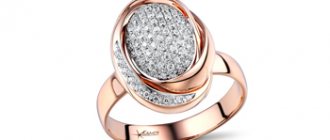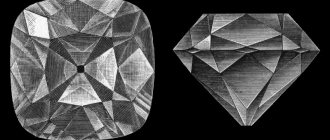| Category | Oxides and hydroxides |
| Title in English | Hematite |
| Formula | Fe2O3 |
| Group | Korunda Group |
| Color | Black red |
| Stroke color | Brown |
| Shine | Metallic, Matte |
| Transparency | Opaque |
| singonia | Trigonal |
| Hardness | 5 — 6 |
| Cleavage | Imperfect |
| Density, g/cm³ | 4,9 — 5,3 |
| Kink | Rough, Conchoidal |
| origin of name | The first description of the hematite stone is found in the Babylonian treatise on stones. This document was written back in the first century BC. Hematite has a characteristic bloody tint, and its peculiarity is that when it is processed, the water turns red. By the way, because of this, the Slavic peoples called the stone “bloody”. The word hematite is derived from the Greek haima, which translates as blood. |
| Morphology | Hematite crystals have lamellar and tabular shapes. In addition, the stone creates simple crystal shapes - these are rhombohedrons, pinacoids and scalenoerds. By the way, clusters of crystals located on planes are close to a pinacoid and form some kind of “iron roses”. Hematite most often occurs in the form of dense cryptocrystalline and earthy masses, foliated and scaly aggregates. |
There is hardly a stone that can compete with hematite in terms of the number of possible names. Thus, in Russian terminology, hematite is found under the name “bloody”, as a literal translation of the Greek word “hematitos”, that is, “like blood”. The old Latin name for the mineral, “sanguine,” also means “blood,” but hematite does not look like blood clots at all. In English terminology, hematites are known as “reflective stones” or specularites. In Germany they are called “iron shine”, and the rusty, knobby growths are called “red glass heads”. Additionally, hematite is variously referred to as “black diamond,” “martite,” and “mirror iron.”
Hematite deposits
Hematite deposits are quite widespread. High-quality samples of jewelry hematite are mined in the USA and Great Britain. Beautiful hematite roses are often found in the northern Urals. Hematites of Transbaikalia are distinguished by unusual shapes. Hematites found in Alaska are black in color and very shiny. They are cut like diamonds and become like black diamonds.
Gem Features
Hematite is a gem with an expressive appearance, different from other stones, and characteristic physical and chemical qualities. However, they may vary somewhat, depending on the type of iron ore.
Characteristic properties of the stone:
- density - low, medium or high;
- metallic or semi-metallic luster;
- forms - sintered, granular, leafy, earthy;
- the color of the trait is only a red-brown tint;
- weak magnetic effect.
The mineral substance slowly disintegrates in hydrochloric acid. A stone with a crystalline structure is distinguished by its fragility - pieces break off easily, and upon impact, cracks form. If the powder from the stone is poured with water, the liquid will become cherry-red in color, reminiscent of blood.
After processing, the gem becomes similar to morion, jet, obsidian and black flint. Distinctiveness - strong metallic shine. Hematite is denser and heavier. Although the stone is hard, it is extremely fragile.
History of hematite
— Advertising —
The word hematite comes from the Greek heme, meaning blood, and refers to the red-brown color of the powder of this mineral, as well as its ability to color water red.
In Christianity, red spots on the stone were considered the blood of Christ, and for this reason, amulets were made from it in the form of the face of Jesus so that the red inclusions looked like blood on his hair.
Different peoples at different times paid attention to magical properties and used this stone. Thus, in Tibet they believed that the mineral protected its owner, especially a woman, from damage and the evil eye. The ancient Egyptians carved hematite scarab beetles.
Bloody Gigantomachy
Long ago, before Deucalion's flood, the Olympian gods waged war with the Titans and terrible monsters.
Monsters of Darkness rose up against Zeus and his divine brothers and sisters - the hundred-armed giants Hecatoncheires, Hydras, Cyclops and hordes of other creatures of Tartarus. This epic battle is reflected in many myths under the general name Gigantomachy (γιγαντομαχία). Vivid episodes of the collision of destructive cosmic forces have come down to us in the magnificent dramatic descriptions of Homer, Apollodorus, and Hyginus.
Greek sculptures
The war of the gods was so significant among the Greeks that it was even reflected in the bas-reliefs on the marble friezes of the Pergamon Altar - one of the wonders of the ancient world.
The Greeks believed that the blood of gods and titans, dripping from the heavenly lists onto the earth, turned to stone. The bloody drops turned into the mineral hematite, and where the bloodiest battles took place, entire deposits of hematite, a blood-colored mineral, were formed. The impression is enhanced by black spots reminiscent of dried blood.
One of the first scientific descriptions of hematite belongs to the Greek scientist Theophrastus (IV century BC).
Physico-chemical characteristics of hematite
Hematites consist of silicon and iron oxides. Depending on their ratio, hematite crystals are colored red, gray or black. Their hardness on the Mohs scale is 6-6.5, specific gravity is 5.3 g/cm3, there is no cleavage, at the fracture they are uneven, conchoidal, opaque, with a metallic sheen.
Take care of your jewelry
Caring for the products is easy. The stone is fragile and is afraid of mechanical stress.
A fall from a height or an impact can irreparably damage the jewelry.
If possible, it is better to place each product in a case or in a separate bag. It is advisable to make them from thick, dense fabric (plush, fleece, velvet).
The stone is cleaned as it gets dirty, without exposure to chemicals. Avoid household chemicals if you are wearing jewelry with hematite.
Once a month, it is useful to hold the bloodstone for a while under running water to cleanse it of energy impurities.
Types of hematite
— Advertising —
For natural hematites, several morphological subspecies are distinguished:
- Iron mica has a scaly, finely crystalline structure and has an iron tint.
- Specularites are distinguished by their crystalline structure and silvery-gray luster. Used as a decorative stone.
- Red Glasshead is a red ore with kidney-shaped stone inclusions.
- Iron Rose is a cluster of flat crystals that resembles a tea rose flower in appearance.
- Red iron ore is a brown mineral with a fine-crystalline structure and a dense arrangement of crystals.
Compatibility with other stones
Iron rose is a conflicting material. It works well with:
- agate;
- emerald;
- heliotrope;
- sapphire.
The combination with carnelian and moss agate is neutral. A contradictory alliance with malachite, onyx, black agate.
Avoid combination with:
- turquoise;
- moonstone;
- sea and river pearls;
- ruby;
- aquamarine;
- diamond;
- aventurine.
Iron mica conflicts with carnelian, amber, beryl, and chrysoprase. Cannot be combined with lapis lazuli, zircon, chrysolite, heliodor.
The breed goes well with emerald
The magical properties of hematite
Hematite is a symbol of courage.
Even in ancient times, it was believed that it gave its owner strength and invulnerability in battles, and preserved optimism, courage and the will to win. Therefore, warriors always took amulets made of hematites with them. In Rus' they believed that a piece of gem suspended over the cradle would protect the child from falls and injuries.
During the Middle Ages, hematite became an important attribute for magicians, wizards and alchemists. They used it to protect themselves from evil forces, appeal to the spirits of the elements, and even communicate with the dead.
Among Europeans, hematite was considered a talisman for warlocks.
In general, hematite improves a person’s energy state, strengthens the body and spirit. Helps its owner cope with attacks of anger and protects against rash actions, gives a feeling of self-confidence and security. It also promotes the rational use of energy, both your own and those around you.
Hematite healing properties
In ancient times, hematite jewelry was used as a hemostatic agent for wounds and inflammatory processes.
Poor vision was treated with hematite powders. And in ancient Rome, during childbirth, women held hematite rosaries in their hands to reduce the intensity of uterine bleeding. Hematite has a good effect on blood circulation, helps normalize blood pressure, increases resistance to stress, and stimulates sexual function. The stone is used in the treatment of diseases of the liver, kidneys, spleen, and pancreas. Hematites also help with various genitourinary diseases.
In lithotherapy, hematite is known to help treat abscesses and blockages of blood vessels.
Product range
Hematite is classified as an ornamental mineral, but is used for making jewelry of all levels:
- Premium segment. The mineral was offered to VIPs by top-tier jewelry brands - Graff, Stella McCartney, Van Cleef & Arpels, Lladro. These are mainly pendants, earrings and cocktail rings with an impressive hematite cabochon in a precious setting.
- Public assortment. A complete set of jewelry in a simple frame with the addition of inexpensive stones.
- Jewelry for esotericists . More often these are rings or pendants in a copper frame with carvings on the surface. Engraving subjects: runes, suras from the Koran, totem animals, plants, names.
- For lovers of the exclusive, original works are performed.
Hematite bracelet
Hematite figurines and “iron roses” are collectible items - spectacular agglomerates with rounded layers-plates reminiscent of a bud. The largest (up to 15-16 cm in diameter) are supplied by Austria. Ural samples are more modest - up to 4.5-5 cm.
Hematite colors
Crushed hematite is always painted in a characteristic blood-red color. The color palette of large images begins with red-brown and ends with bright scarlet and cherry shades. The color of a hematite crystal, depending on the content and amount of impurities, can also vary from dark gray to black. Polished hematite has a characteristic bluish metallic tint.
How to distinguish real hematite from a fake
Natural hematite is widespread, but it is still more difficult to find and process than to counterfeit, which is why fakes appear on the market.
To check the authenticity of hematite, pay attention to the weight of the stone. The natural mineral contains a high percentage of iron, and therefore it is quite heavy, unlike fakes.
In addition, to identify fakes, a stone is passed over the light, rough surface of porcelain or ceramic product. A natural specimen will leave a blood-red mark on it.
Fake or real
The stone is quite common, so a person with almost any income can buy it. It is not often counterfeited. But fakes still exist. But if you want to check, there is an easy test.
- You can identify a fake by its line. In natural hematite it is always dark red. We take unglazed porcelain or earthenware and draw a line with force several times.
- An imitation of hematite is offered for sale - hematin (an alloy of steel with chromium and nickel sulfides). Externally and in many characteristics, it is almost indistinguishable from bloodstone. The difference is small. Hematite has very weak magnetic properties (or none at all). Hematin's magnetic properties are slightly more pronounced. Here the gemologist will think about whether hematite or hematin is in front of him.
- As a cheap imitation option, you may be offered simple ceramics. It is easy to distinguish by its weight. Hematite is a heavy mineral; compared to most minerals, it is noticeably heavier in the palm.
Try all methods. If you are not confident in the naturalness of the stone, go to a gemologist.
Interesting facts about hematite:
Hematite gives its owner courage and bravery, which is why the stone is considered a talisman for men, especially for the military. In ancient times, a piece of hematite was sewn into clothes, placed in shoes, or made into a pendant for all men going to war. It was believed that such a talisman would definitely protect a warrior from death, and also make his enemies weak. Hematite talismans help women with professional growth and starting new things. Hematites are best suited for silver frames. Men are recommended to wear rings with it on the right index finger, women - on the left.
- The Indians used hematites to obtain a red pigment, which they applied to the skin of the face before going on the warpath. It was concluded that the warrior was brave and courageous, and returned alive.
- In ancient times, mirrors were made from shiny hematites. However, later a legend spread that such a mirror could take the soul of anyone who looked into it, and such mirrors fell out of popularity.
Compatibility with Zodiac signs and names
The breed is associated with Mars. Jewelry with it is suitable for people living under the auspices of this planet.
Black diamond is especially useful for the zodiac signs:
- Scorpion;
- Aries;
- Cancer.
Decoration helps to achieve success in the business you have started. Cancers become more confident, Scorpios take control of their feelings, Aries successfully take risks and win.
Hematite is contraindicated:
- Virgos;
- Gemini;
- Libra.
Decorations are allowed for other signs, but will not bring much benefit.
The breed patronizes the names:
- Anya (protects from self-destruction);
- Natasha (moderates pride, sensuality);
- Raisa (brings happiness);
- Petya (weaken adventurous tendencies);
- Vadim (useful in adulthood);
- Nikita (cultivates optimism).
The stone protects Scorpios
